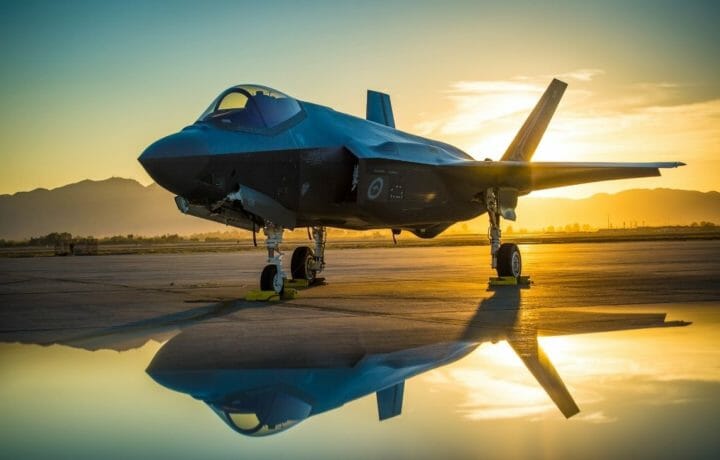On July 1, Lockheed Martin reported that the F-35 Global Fleet surpassed 400,000 Flight Hours. “This milestone is a testament to the dedicated work of the joint government, military and industry teams sustaining, maintaining, operating and flying F-35s around the globe,” Lockheed Martin’s general manager of the F-35 Program, Bridget Lauderdale, stated last week. However, as the F-35 program matures, so does the importance of the F-35 mission.
F-35 in Action
In late June, a blended U.S. Marine, U.K. Royal Air Force Air Wing aboard HMS Queen Elizabeth launched F-35Bs on an anti-ISIS air strikes. Both British and American F-35B Lighting II Joint Strike Fighters flew the anti-ISIS strike missions, which were the first for the U.K. in a decade. Commodore Steve Moorhouse, commander of the U.K. Carrier Strike Group, recently stated, “The involvement of HMS Queen Elizabeth and her air wing….demonstrates the speed and agility with which a U.K. led Carrier Strike Group can inject fifth generation combat power into any operation, anywhere in the world”.
As for the U.S, the operation provides a significant increase in interoperability, global deterrence and strike capability if needed. Recently, Lt. Col. Andrew D’Ambrogi, the commanding officer of Marine Fighter Attack Squadron 211 (VMFA-211) stated, “We have never seen a ship with 18 F-35s out there that is going to transverse half the world like we’re going to do……. It’s a pretty bold statement. It’s about power projection.”
The United Kingdom is not our only ally on the program. The F-35 is developed, produced, and supported by an international team aerospace industry leaders and government allies. Managed by the Pentagon’s F-35 Joint Program Office, the U.S. Air Force, the U.S. Marine Corps and the U.S. Navy are all procuring and operating F-35s. Perhaps lesser known are the United States’ eight international program partners: the United Kingdom, Canada, Italy, Netherlands, Australia, Norway, and Denmark. There are also six Foreign Military Sales customers procuring and operating the F-35: Israel, Japan, South Korea, Poland, Belgium and Singapore. Lockheed Martin serves as the prime contractor with a global supply chain of more than 1,900 companies based in the United States and in nations acquiring the F-35.
The F-35′s interoperability technology strengthens our alliances around the world. Interest in the program and aircraft are growing. Last winter the U.S. State Department gave the green light to Finland and Switzerland to purchase the F-35 aircraft. The countries are still competitively biding the f-35 against other competitive technology, but it is interesting that friendly non-NATO countries are now seriously considering America’s fifth-generation, front-line fighter.
Demand for the F-35 Growing
But why is demand continuing to grow? Interest in the F-35 is driven by a desire for a fighter that will not rapidly become obsolete after delivery. Perhaps more importantly, we and our allies recognized the necessity of improving our collective interoperability.
A year ago, the U.S. Government gave a green light to Japan’s $23B purchase of 105 F-35 joint strike fighters. The approved package includes 63 F-35A conventional takeoff and landing aircraft and 42 F-35C short takeoff and landing variants, potentially making Japan the largest foreign customer of the Lockheed Martin-produced jet.
Just last week, Defense News announced, the Italian Navy aircraft carrier Cavour will receive its first F-35B in a few days. The Cavour started certification work in the U.S. earlier this year to host the aircraft with the fighter undergoing final checks at the Cameri air base in Italy. In total, Cameri will checkout 90 F-35s, including 30 F-35Bs for Italy.
Last month, the F-35 Lightning began trials aboard Royal Navy’s (RN’s) second aircraft carrier, HMS Prince of Wales. The first landing of a Lockheed Martin F-35B Lightning combat aircraft aboard the carrier was on the 9th of June. This event was considered another milestone in the ongoing sea trials being conducted off the south coast of England, advancing towards a full operational capability.
Overall, thirteen countries have committed to orders of the F-35 Joint Strike Fighter either as a formal partner nation or through foreign military sales. With sales and production of the fifth-generation systems increasing, the F-35 Joint Program Office and Lockheed Martin look to expand the global footprint. Recently, Lockheed Martin vice president and F-35 program manager Bridget Lauderdale stated, “With every delivery and every flight hour, the enterprise gets more mature and effective, and we are laser focused on continuing to deliver the most capable, available, and affordable 5th Generation fighter aircraft.”




